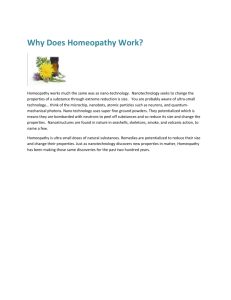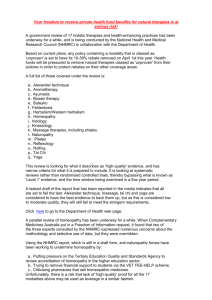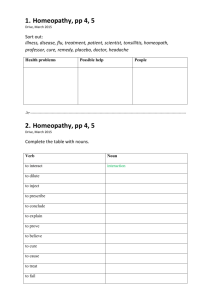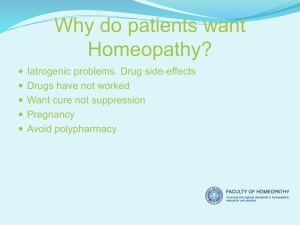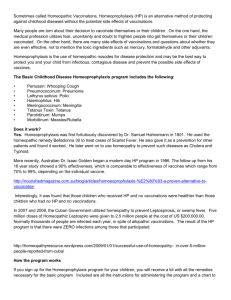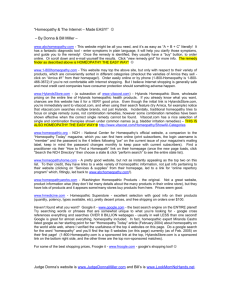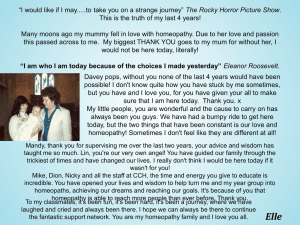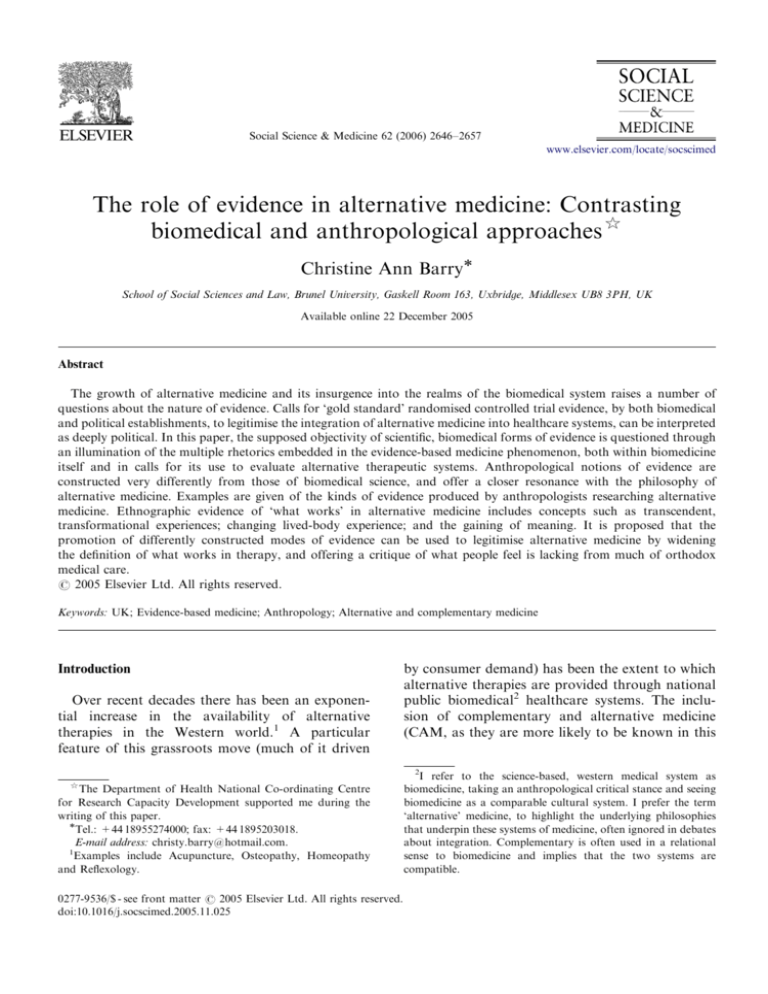
ARTICLE IN PRESS
Social Science & Medicine 62 (2006) 2646–2657
www.elsevier.com/locate/socscimed
The role of evidence in alternative medicine: Contrasting
biomedical and anthropological approaches$
Christine Ann Barry
School of Social Sciences and Law, Brunel University, Gaskell Room 163, Uxbridge, Middlesex UB8 3PH, UK
Available online 22 December 2005
Abstract
The growth of alternative medicine and its insurgence into the realms of the biomedical system raises a number of
questions about the nature of evidence. Calls for ‘gold standard’ randomised controlled trial evidence, by both biomedical
and political establishments, to legitimise the integration of alternative medicine into healthcare systems, can be interpreted
as deeply political. In this paper, the supposed objectivity of scientific, biomedical forms of evidence is questioned through
an illumination of the multiple rhetorics embedded in the evidence-based medicine phenomenon, both within biomedicine
itself and in calls for its use to evaluate alternative therapeutic systems. Anthropological notions of evidence are
constructed very differently from those of biomedical science, and offer a closer resonance with the philosophy of
alternative medicine. Examples are given of the kinds of evidence produced by anthropologists researching alternative
medicine. Ethnographic evidence of ‘what works’ in alternative medicine includes concepts such as transcendent,
transformational experiences; changing lived-body experience; and the gaining of meaning. It is proposed that the
promotion of differently constructed modes of evidence can be used to legitimise alternative medicine by widening
the definition of what works in therapy, and offering a critique of what people feel is lacking from much of orthodox
medical care.
r 2005 Elsevier Ltd. All rights reserved.
Keywords: UK; Evidence-based medicine; Anthropology; Alternative and complementary medicine
Introduction
Over recent decades there has been an exponential increase in the availability of alternative
therapies in the Western world.1 A particular
feature of this grassroots move (much of it driven
by consumer demand) has been the extent to which
alternative therapies are provided through national
public biomedical2 healthcare systems. The inclusion of complementary and alternative medicine
(CAM, as they are more likely to be known in this
2
$
The Department of Health National Co-ordinating Centre
for Research Capacity Development supported me during the
writing of this paper.
Tel.: +44 18955274000; fax: +44 1895203018.
E-mail address: christy.barry@hotmail.com.
1
Examples include Acupuncture, Osteopathy, Homeopathy
and Reflexology.
0277-9536/$ - see front matter r 2005 Elsevier Ltd. All rights reserved.
doi:10.1016/j.socscimed.2005.11.025
I refer to the science-based, western medical system as
biomedicine, taking an anthropological critical stance and seeing
biomedicine as a comparable cultural system. I prefer the term
‘alternative’ medicine, to highlight the underlying philosophies
that underpin these systems of medicine, often ignored in debates
about integration. Complementary is often used in a relational
sense to biomedicine and implies that the two systems are
compatible.
ARTICLE IN PRESS
C.A. Barry / Social Science & Medicine 62 (2006) 2646–2657
context) within science-based medical systems has
become known as integrated (UK) or integrative
(USA) medicine.
Concurrent with this rise in alternative and
integrated medicine there has been a movement
towards increasing reliance on science-based research to judge the effectiveness of treatments,
otherwise known as evidence-based medicine
(EBM). In this paper, I focus on the UK context
in discussing debates connecting the EBM movement with alternative medicine. I then go on to
investigate the different notions of evidence produced in anthropological research on alternative
medicine.
I wish to problematise the call from within
biomedicine for more evidence of alternative medicine’s effectiveness via the medium of the randomised clinical trial (RCT). This call originates in
part from the motive of ensuring that alternative
medicine ‘works’ before providing it in a publicly
funded service. I will suggest, however, that this call
is also, in part, political and relates to the agenda of
controlling the threat posed by alternative medicine
to the long-standing hegemony of biomedicine in
the West. I also want to highlight possible omissions
and biases inherent in the RCT method, not always
visible to its supporters. RCTs usually omit the
measurement of important elements of ‘what works’
in alternative medicine, which often acts in a
different way to biomedical drugs. By presenting
ethnographic evidence, I wish to show how evidence, when seen from the perspectives of the users
and practitioners of alternative medicine, hinges on
a very different notion of therapeutic efficacy.
My interest in this debate arises from my
experience as a patient of both biomedicine and
alternative medicine.3 I can contribute from an
outsider perspective, neither being a biomedical nor
an alternative practitioner, but also from an insider
perspective of having experienced both as a user.
Having conducted research in general practice
(Barry, Stevenson, Britten, Barber, & Bradley, 2001)
and alternative healthcare systems (Barry, 2003), I
find debates on the production of evidence in
alternative medicine, lead by biomedically trained
commentators (for example, Ernst, 2002), ignore
most of the aspects that advocates of alternative
therapies draw on as evidence of therapeutic
effectiveness.
3
I turned to acupuncture, when biomedicine failed to treat a
chronic condition.
2647
Integrating alternatives into the NHS: the role of the
RCT
In Britain the CAM integration debates have
been most vocal from within the medical establishment, albeit at the fringes. Central to this debate has
been the Foundation for Integrated Health’s campaign to increase CAM in the National Health
Service (NHS), and the House of Lord’s Select
Committee on Science and Technology (2000)
report on CAM. In a medical system currently
dominated by discourses of EBM, the integration
debate has centred on the pivotal issues of regulating CAM professions and producing evidence to
prove such therapies merit inclusion in the NHS. In
fact Baer (2004) differentiates this new CAM or
integrative movement from its predecessor of
holistic medicine, through its emphasis on EBM.
Evidence in this CAM context is conceived of as
therapeutic efficacy for biomedically diagnosed
disorders, within the individual body (or body
part), and as measurable utilising science-based
research strategies, most notably the randomised
controlled trial.
These assumptions reflect a biomedical orientation towards ‘healthcare technologies’ (such terminology itself denotes a separation of treatments
from: the people they treat, the people providing
them, and the settings in which they are provided).
In an alternative orientation such a separation
makes no sense, as the therapeutic effect does not
reside inside a homeopathic remedy, for example,
but in an energetic system that comprises the
patient, the remedy, the healer and the setting.
Homeopathy as conducted by a homeopathically
trained biomedical GP in an NHS practice was so
different from the practice of lay homeopaths as to
be unrecognisably the same therapy (Barry, 2005).
The GP prescribed homeopathic remedies for
biomedical diagnoses, collecting little information
from patients. The professional homeopaths prescribed on the totality of symptoms, many nonmedical, which necessitated much more complex
consultations.
The nature of Homeopathy precludes the
straightforward administration of clinical trials to
measure it. Based on the principle of treating like
with like, homeopathic remedies are developed from
substances in the natural world. A picture of the
symptoms of these substances is catalogued by
‘proving’ the effects on healthy volunteers. A muchdiluted form of the remedy is then administered to
ARTICLE IN PRESS
2648
C.A. Barry / Social Science & Medicine 62 (2006) 2646–2657
patients suffering with a picture of symptoms that is
closest to that particular remedy. Each remedy
picture includes multiple physical symptoms in
multiple body locations, diverse psychological and
emotional states, and aspects of behaviours that are
not part of biomedical diagnoses. For example
symptoms that improve on violent motion, particularly dancing (irrelevant to a biomedical diagnosis)
is one of the keynote aspects of the symptom picture
for Sepia (Vermeulen, 2000). Different individuals
with the same biomedical diagnosis will be prescribed different remedies, as their symptom and
personality picture will likely be different in each
case. So two important aspects of homeopathy,
individual prescribing and attention to non-biomedically recognised ‘symptoms’, problematise the use
of RCT methodology.
RCTs carried out on alternative therapies necessarily entail reducing the complexity of the intervention to fit the reductionist nature of the RCT
method. As a result, the therapeutic intervention as
tested in RCTs is in most cases quite different to the
interventions used by alternative practitioners in
everyday clinic situations.
Evidence-based epistemology can in itself have
transformative effects on alternative therapies.
Villanueva-Russell’s (2004) sociological case study
shows how the development of clinical guidelines
has influenced some practices within chiropractic.
She suggests such guidelines are at odds with the
approach and work of purist chiropractors, whom
she calls ‘straights’ who follow a vision of vitalism,
seeing their work as aiming to ensure a free flow of
innate intelligence through the body. The guidelines
were skewed in favour of the agenda of the
adulterated practice of medicalised chiropractors—
the ‘mixers’—who have divorced the epistemological foundations from the mechanistic practice of
manipulation. This research demonstrates how
scientifically constructed ‘evidence’ for an alternative therapy only works when the therapy has
mutated into a medicalised version and divested
itself of its alternative philosophy. Quah (2003)
makes similar claims for the incompatibility of
science-based evidence with traditional Chinese
medicine.
Tonelli and Callahan believe CAM is a field of
enquiry for which suitable methods diverge from the
traditional science-based view: ‘The methods for
obtaining knowledge in a healing art must be
coherent with that art’s underlying understanding
and theory of illness. Orthodox medicine should
consider abandoning demands that CAM become
evidence-based, at least as ‘‘evidence’’ is currently
narrowly defined, but insist instead upon a more
complete and coherent description and defence of
the alternative epistemic methods and tools of these
disciplines’ (Tonelli & Callahan, 2001, p. 1214).
Rhetorics of evidence in biomedicine
I do not wish to discredit the notion of the RCT.
In its purest ideological form, the concept of
offering patients only therapeutic interventions that
have been proven to work is unquestionably
sensible and morally correct. Where the problems
arise is the imperfection of the RCT tool as an
arbiter of what works, because it measures the
wrong things or the wrong populations. The real
world clinical context is different to the trial
laboratory. The RCT can sometimes become a
victim of hubris. Just being the ‘gold standard’ is
not enough—it is still an imperfect tool. Even the
most elegantly designed trial with statistically
beneficial sample sizes and clever protocols for
blinding usually measure only a subset of symptoms
and therapeutic effects (those that are short-term
and easiest to measure). The production of scientific
evidence is a social as well as a scientific process.
There is no such thing as The Evidence, just
competing bodies of evidence.
As part of a broader cultural movement towards
the audit culture (Maguire, Shore, & Wright, 2001),
‘evidence’ has become an increasingly strong rhetoric in biomedicine in the last few years. This is not
without criticism from both within and without.
There are, for example, ongoing extensive debates
about EBM among biomedical practitioners
(Lambert, this volume).
One explanation for its rise is that the NHS is
becoming an increasingly managerial system.
Greenhalgh (1999) argues that EBM is driven by
those with managerial rather than clinical backgrounds. Overt rationing of healthcare services
through the use of committees such as NHS trusts
and the National Institute for Clinical Excellence
(NICE) requires decisions about resource allocation
to be based on evidence of efficacy and costeffectiveness of treatments.
The optimum evidence for this task is the ‘gold
standard’ of the RCT, or preferably the Systematic
Review of a number of RCTs, which has come to be
positioned at the top of the evidence hierarchy
(Lohr, Eleazer, & Mauskopf, 1998).
ARTICLE IN PRESS
C.A. Barry / Social Science & Medicine 62 (2006) 2646–2657
Timmermans and Berg (2003) propose that the
introduction of clinical practice guidelines (based on
trial evidence) in the 1980s, was motivated by the
medical professions’ need to claim exclusive expertise in healthcare. The guidelines embodied the
extent of medicine’s jurisdiction and created a
‘market shelter’ protecting the stock of knowledge
from competition. They conclude that EBM serves
some goals at the level of the professions but hardly
makes a difference at the level of the work these
professionals do. They report minimal guideline
compliance with only 15–66% of clinicians aware of
guidelines, and of those who have read them, less
than a third report changes in their behaviour as a
result. In the UK, implementation of NICE guidelines has also been found to be patchy (Sheldon
et al., 2004). The difficulties implementing innovations in health services are not to be underestimated,
and whilst robust scientific evidence may be
necessary, it is not sufficient for change (Dopson
& Fitzgerald, 2005).
Berg and Mol demonstrate that in spite of a
rhetoric of standardisation through evidence-based
guidelines, there exist enormous variations in
medicine and that medicine should not be seen as
a coherent whole, rather as a heterogeneous
coalition. They argue that ‘protocols do not create
homogeneity, but introduce new kinds of diversity
in medical practices’ and that ‘Medicine does not
fail to meet the standards. The standards fail to
meet reality’ (Berg & Mol, 1998, p. 10).
There is also the issue of bias in funding of trials
and the vested interests of the powerful pharmaceutical industry influencing the so-called neutrality and
objectivity of much RCT data (de Vries & Lemmens,
this volume). ‘It takes a lot of gold to meet the gold
standard of the clinical trial’ (Hess, 1998, p. 17), and
in alternative medicine there are rarely powerful
pharmaceutical interests, with the exception of
herbal products, and therefore few trials.
In addition to the question of availability of
evidence, concepts embedded within the notion of
RCT evidence are problematic. A placebo in
medical terms is supposed to be an inert substance
yet it is known to exert around a 35% improvement
effect (Beecher & Boston, 1955). Di Blasi and
Kleijnen (2003) demonstrate that the existence of a
placebo option is capable of changing patient
responses even in non-placebo arms of an RCT.
Just knowing that they might potentially be on
placebo reduced the response of participants given
an active drug.
2649
Wolpe (2002) raises the paradox that many of the
most powerful phenomena in orthodox medicine,
the placebo effect, psychosomatic illness and spontaneous remission, which can account for large
percentages of healing rates, get very little research
attention. Mythological, ritualised and culturally
embedded aspects of all healing systems, biomedicine included, can in themselves possess great
healing potential. Orthodox medicine can be blind
to such aspects of its own praxis in its claim to
scientific legitimacy, and these elements are not
studied in the RCT. Yet it is often these very aspects
that attract patients to CAM.
EBM has also been conceptualised as ritualised
behaviour, that does not actually encourage changes
in clinical practice, in Sinclair’s (2004) ethnographic
research of EBM teaching in psychiatry. Such an
interpretation supports the idea that EBM might
have non-practical, symbolic advantages to the
profession of medicine, without changing practice.
It would seem that the notion of scientific evidence
in biomedicine should be treated as complex and
serving multiple agendas.
So given the inherent problems in notions of
evidence, preoccupations with evidence as the
preferred basis for good medicine can be seen to
constitute a form of rhetoric. I can identify three
further rhetorical aspects. The first is the preponderance of gaps in the evidence base. How can EBM
be possible when there is either no available
evidence or the quality is suspect (Linde & Willich,
2003)? Systematic reviews use criteria for assessing
quality of RCTs and reject a lot of trials. There is a
hierarchy of evidence according to the ways in
which the study has been conducted, points being
assigned for randomisation, controls and blinding.
Therefore, the use of RCT methodology is not itself
a guarantee of sufficient quality to produce solid
evidence.
The next rhetoric is that the relationship of RCT
evidence to the reality of clinical practice is often
seriously de-contextualised and so manipulated as
to be unrepresentative of actual treatment and
patients in the clinic. For example, the Royal
London Homeopathic Hospital have very little
success recruiting patients for trials of homeopathy.
Their patients refuse to consider the possibility of
being in a placebo arm. Such patients are very
committed to taking homeopathy and have often
been on a long waiting list. In their place, trialists
have to recruit from general practices to find
patients willing to be randomised (Peter Fisher,
ARTICLE IN PRESS
2650
C.A. Barry / Social Science & Medicine 62 (2006) 2646–2657
Table 1
Problems with basing biomedical practice on rhetorics of evidence
1
2
3
4
5
6
7
8
9
10
RCT methodology measures what is easily measurable ignoring subtle and complex effects
RCTs pay little attention to the context or provider of treatments
The placebo concept has powerful healing properties not fully acknowledged in RCT methodology
Funding for trials is patchy and biased towards products with pharmaceutical industry interests
EBM can be seen as a political move to protect the medical professions’ exclusive expertise in healthcare
EBM can be seen as benefiting hospital managers more than clinicians and arising from the growth of managerialism and audit
culture
Compliance with guidelines derived from evidence is low
Teaching of EBM to clinicians can be conceptualised as ritualised practice that does not impact on clinical practice
Evidence may be in conflict with patients’ wishes in patient-centred medicine
RCTs come low down in the hierarchy of patients’ decision making factors
personal communication). Such recruits may be
very different to many homeopathy patients. Being
committed to homeopathy makes patients more
likely to comply with homeopathic treatment over
the long term and also makes them more likely to
judge it successful (Barry, 2003). The patient, it is
sometimes forgotten, is a very powerful ingredient
in the mix of factors to achieve a successful
intervention. Patients’ belief systems and emotions
have been shown be very instrumental in healing
outcomes through the study of psychoneuroimmunology (Pert, 1999).
Ignoring such individual factors, the trial method
works at the statistical level of populations and
‘average’ patients rather than real patients. However, average patients are not an average of the
whole population, only of the population of trial
consenters. Trials are often peopled with middleclass, white, male patients with no co-morbidity
(Tudor-Hart, 1993), yet in reality many patients are
on several different drugs. Tudor-Hart demonstrated that only 10% of people with hypertension
have an uncomplicated version that would be
appropriate for the application of standard guidelines, making these irrelevant for the 90% majority.
The average patient is often therefore just an
artefact, not representative of real patients.
A final problem with the rhetoric of EBM is the
conflict with other accepted healthcare policies, such
as patient-centred medicine, characterised by increasing involvement of patients in decision-making
about healthcare (Bensing, 2000; Lambert, this
volume). If a patient expresses a strong desire for
a treatment, regardless of evidence-based guidelines,
it may be impossible to satisfy the needs of both
patient-centred medicine and EBM (Table 1).
While these rhetorics of evidence are very powerful, they encompass only one formulation of
evidence within biomedicine. For clinicians dealing
with their patients, RCT evidence is just one form of
evidence they use in their daily lives, alongside
clinical judgement—the art versus the science of
medicine. General Practitioners, for example, combine formal knowledge such as that gleaned from
textbooks and trials, with the case specific features
of the individual patient’s story (Greenhalgh, 1999).
They also draw on more experiential and intuitive
evidence, the accumulated expertise of dealing with
many such individual cases over time.
So the rhetoric of evidence as encapsulated in the
RCT represents only one, albeit powerful, formulation of evidence in biomedicine. What effect has this
powerful evidence-based rhetoric had in the world
of alternative medicine?
Evidence and alternative medicine
Alternative medicine in the past has shown little
interest in producing RCT evidence. Its proponents
are less embedded within a science-based epistemology, there is no money available, and there has been
an awareness of the limitations of such methodology for studying complex individualised treatments
(Long, Mercer, & Hughes, 2000).4 However, increasing integration requires alternative therapists
to start to play the ‘evidence’ game. Alternative
practitioners who take up research projects often
want to use research for political ends to validate
therapies and to improve access by getting alternatives accepted in NHS settings. Most Primary
4
CAM therapists are not alone; physiotherapists have raised
similar doubts about the use of RCTs to pinpoint the processes of
their therapy (Dopson & Fitzgerald, 2005).
ARTICLE IN PRESS
C.A. Barry / Social Science & Medicine 62 (2006) 2646–2657
2651
Table 2
Problems with alternative medical practice and rhetorics of evidence
1
Alternative interventions are often complex and multi-stranded; e.g., most alternative practitioners also recommend lifestyle
changes such as diet
Alternative therapies are quite different when practised in the NHS versus outside
Committed users of alternative therapies interact with a therapy quite differently from biomedically minded patients
The phenomenon labelled ‘placebo effect’ in RCTs is recognised as a powerful intrinsic component of alternative healing
Few alternative therapies are allied to powerful industry interests
EBM can be used as a tool to limit threats to biomedicine’s power from alternative therapists
NHS managers are unlikely to appreciate the benefits of alternative therapies in the absence of hard data
RCT evidence alone will not lead to implementation of alternative therapies into the NHS
Patients who choose alternative therapy are often against orthodox treatments, whatever the evidence
2
3
4
5
6
7
8
9
Care Trusts5 will not provide alternative medicine
services to their constituency unless the proposer
can support their request with RCT evidence.
Some biomedical researchers involved in the
production of trials wish to quash the rise of
alternative medicine, and RCT evidence can be
used as a tool to discredit it and bar it from the
NHS. RCT data are being used to limit the activities
of non-medical complementary therapists. For
example, most cancer hospital departments now
employ acupuncturists, aromatherapists and/or
reflexologists who are often instructed to limit their
interventions to the alleviation of side effects of
treatments, rather than any treatment of the cancer
or the patient as a whole. In part this is because
RCTs have not been conducted on the effects of
treatment on the whole person, only on specific
symptoms, such as alleviation of chemotherapyrelated nausea. However, whole system acupuncture, for example, may benefit patients’ healing
responses.
In alternative models of healing, effectiveness is
often constructed very differently. In homeopathy
short-term cures are only seen as appropriate to
acute and minor illnesses. Homeopathy views
treatment for chronic and serious illnesses extending
over long timescales. A private patient of lay
homeopathy explained ‘over the last few years my
homeopath has really improved my hay fever’
(Barry, 2003). On the other hand, a more biomedically inclined patient of a homeopathic GP said she
had given up on the homeopathic remedy after 3
days when it had not worked on her hay fever.
Another patient of a lay homeopath reported
working through a repetition of old symptoms of
all the health problems she had experienced since
5
Primary Care Trusts are the administrative units that hold
budgets and allocate resources in primary care.
childhood, over a 3 year period: ‘asthma then
eczema then allergic sneezing for 12 months then
conjunctivitis, stomach problems and finally thrush
which I had as a baby’ (in homeopathic healing the
notion of the return and resolution of old symptoms
is seen as beneficial in the restoration of health).
The very publication of trials can act as a
reformulation of the very nature of a therapy,
generally in the direction of medicalisation. Where
homeopathy has been tested on a biomedically
diagnosed
disorder, rhinitis,
for
example
(Schapowal, 2002), it suggests to the readers that
homeopathy can be used in a biomedicalised way,
for medical conditions across a population of
sufferers, ignoring the mental, spiritual, and relational picture in favour of physical symptoms.
In a lay homeopathy clinic, I observed patients
with rhinitis symptoms being prescribed very
different remedies. One patient’s nasal drip was
accompanied by feelings of fear and distress about a
recent mugging, unresolved grief from her parents’
death and a metallic taste. Another patient with
nasal drip reported menstrual problems, relationship issues and feelings of unexpressed anger. In the
Schapowal (2002) trial, both would have been given
the same remedy, Butterbur, yet neither were
prescribed this remedy.
In homeopathy training, students are told that if
a remedy that does not match the total symptom
picture, it is seen as an inert substance. For a
remedy to be active, the ‘similimum’, it has to be
have the most similar symptom picture to that of
the patient. Under this logic, many of the prescriptions of Butterbur in the trial would have been inert
and useless, in spite of the shared biomedical
diagnosis of rhinitis.
After conducting an RCT, Elaine Weatherly
Jones, a non-medical homeopath, reported a ‘change
of heart’ on the usefulness of this method for
ARTICLE IN PRESS
2652
C.A. Barry / Social Science & Medicine 62 (2006) 2646–2657
researching such an individualised form of therapy
(Weatherly Jones, 2004). Unusually, she interviewed
the trial practitioners who reported that the blinding
procedure interfered with their normal practice
routines, to produce a radically different version of
their normal therapeutic practice (Table 2).
The response of biomedicine to the growth of
alternatives
Macro-analyses suggest that the response of
biomedicine at the system level, to the growing
popularity of alternative medicine, can be interpreted as politically motivated. Mike Saks suggests
RCT evidence is being used strategically by
biomedicine’s medical associations, to reduce potential threat from alternative medicines, feeding
into incorporationist and assimilationist policies
(Saks, 1996). In one case study Saks charts how
the British Medical Association (BMA) moved from
a completely hostile position of total exclusion of
alternative medicine (in their 1986 report) to an idea
of embracing collaboration with non-medically
qualified alternative practitioners (in their 1993
report). Saks interprets this U-turn as a heavily
defensive, politically motivated strategy, aimed at
reducing the potential threat to biomedicine’s
position, in terms of power, income and status,
from alternative therapies. Baer (2004) has noted
similar shifts within the American Medical Association, and interpreted them similarly.
Another example of attempts to control the impact
of alternative medicine, through defensive strategies, is
evidenced by the impassioned hostile response to
RCTs published in mainstream medical journals. Such
trials usually produce a furore of response from
individual doctors and scientists. In the British
Medical Journal, Taylor et al. (2000) published an
overview of four trials of homeopathy in perennial
allergic rhinitis. There were an unusually large number
(61) of electronic rapid letter responses, mostly
dismissing these positive findings, often using emotively charged phrases: ‘The Emperor’s New Therapy’,
‘Homeopathy is ridiculousy. Preposterous’, ‘Like the
sprinkling of holy water on vampires’ (see responses
on www.BMJ.com after Taylor et al., 2000).
The nature of evidence in anthropology
Although any one system of medicine covers a
broad and varied range of practices and philosophies, contextualised accounts of practices and
processes in specific circumstances are notably
lacking in most forms of research. RCT research
and survey research, for example, do not tend to
investigate the detailed context in which healthcare
was provided. However, Verhoef has recently called
for the use of qualitative research to monitor the
context, process and practice within clinical trials
so that conceptual generalisations can be made
(Verhoef, Casebeer, & Hilsden, 2002).
Just as the scientific laboratory method and the
nature of population statistics have shaped the
nature of RCT evidence, so too anthropological
method influences what constitutes evidence. Ethnographic research is conducted in everyday reallife settings and so can pay attention to the
all-important contextual features of interaction.6
Reality is seen as ever-changing through a series of
processes, formed by interactions and relationships
between people, and always affected by the context
in which social actions take place. The method
utilises an observer situated in the context, not
researching from afar. The focus of research is
neither wholly predetermined nor tightly structured.
This allows for research to uncover issues of
importance to participants that may have been
ignored in the literature. Shifting the focus to the
perspective of the actors involved, and seeking the
native point of view, not mirroring the prior
concerns of the academic community, can produce
powerful new interpretations (O’Connor, 2002).
In ethnography real-life interactions between
members of a community or setting are recorded,
paying attention to the ways in which people
construct the meaning of an event together. Other
research methods such as surveys or focus groups
usually canvass the views of one particular group—
patients, for example. Ethnographic research recognises that it is the interaction between a specific
patient and their specific healthcare practitioner
that needs to be looked at, as a system, and so
would look at what happens in the actual interactions between them. My previous work in general
practice is an example of how different data
collection methods reveal quite different interpretations of events (Barry, 2002a). Qualitative data
collection techniques usually favour either the
investigation of practices or meanings (Silverman,
1998). Ethnography is particularly powerful as it
usually investigates both. Anthropologists, as a
6
Ethnography is also used by sociologists, educationalists,
nurses and others.
ARTICLE IN PRESS
C.A. Barry / Social Science & Medicine 62 (2006) 2646–2657
result, are very aware of the difference between the
ideal and the real, through both listening to what
people say about their behaviour and actually
watching what they do, which can be very different
(Lambert, 1998).
Embodied and inter-subjective data are acceptable evidence in anthropology. Ethnographers pay
attention to how people feel in their bodies and how
they relate to each other. Action is analysed over
long timescales, fieldwork extends for months,
sometimes years. The anthropologist’s main tool is
her/himself. Thus the collection of evidence is not
through randomisation and standardisation but via
personal, individual ways of knowing. This incorporates the utilisation of the anthropologist’s
emotions, intuitions, relations with others, and
own bodily responses (Turner, 2000; Laderman,
1994). It also requires the anthropologist to account
for her/his presence in the research through
reflexivity, paying attention to the impact they have
on the production and interpretation of data
(Davies, 1999; Barry, 2002a, 2002b). It is, however,
worth noting that in our increasingly audit driven
culture, pressure from funders is increasingly
forcing standardisation even on anthropologists
(Maguire et al., 2001).
Evidence on alternative medicine in anthropology
There has been relatively little study of the use of
alternative therapies in western settings by anthropologists (Micozzi, 2002). Anthropologists mainly
study cultures from other parts of the world.
Although there is a growing tradition of ‘anthropology at home’ in western cultures, medical
anthropologists working ‘at home’ have traditionally focused exclusively on the sub-culture of
biomedicine (for example, Good, 1994).
McGuire conducted one of the first ethnographies
of alternative practices in America, showing how
healing was seen to work primarily through
providing meaning to its participants (McGuire,
1988). Some kind of order was created in their
personal lives, through the naming of illness and its
causes, in non-biomedical terms. Symptoms and
other aspects of life were connected in a meaningful
narrative. When patients evaluated the ‘success’ of a
treatment, changes in identity and self were
experienced as more important than physical
improvements. The shaping of meaning of bodily
experience was central. Evidence of the therapy’s
2653
success was seen in its effect on understanding as
much as on bodies.
One very powerful theoretical strand in medical
anthropology that is relevant to the study of
alternatives is the work on embodiment. Csordas
(1990) explains that embodiment requires that
research investigate the phenomenology of the lived
body using more creative methodologies to deal
with processes, in both the researcher and the
researched, such as intuition, somatic perception,
bodily imagination and sensation. He used subtle
and interpersonal methods to study healing in a
charismatic Catholic Pentecostal community (Csordas, 1997). Analysing his own bodily experiences,
and those of the congregation, he shows how the
presence of collective bodies in this church produced
co-ordinated action and sensory stimulation,
through chanting, drumming, dance and/or drama.
The resulting changed bodily states were experienced as therapeutic.
In an ethnographic study of a Chi Gung exercise
class, attendees reported a sense of alienation in
their dealings with western medical practice and its
reductionism (Busby, 1999). They experienced a
sense of coming home to a practice that was more
congruent with their lived experience of their bodies.
Their Chi Gung practice not only reflected their
everyday bodily experience more accurately, it
invited new ways of thinking. The idea of an
intelligent nature within the body, and the importance of flow and release as healing movements,
were well received in contrast to more mechanistic
biomedical versions of the body.
Adams’ (2002) comparative ethnography of
shiatsu as practised in Japan and the UK illustrates
how in each country the therapy is practised quite
differently and reflects the local culture and context.
Adams utilised an auto-phenomenological approach to investigate the experience of a shiatsu
session from both therapist’s (himself) and client’s
viewpoint. By presenting the mental imagery
reported by the client, alongside an analysis of his
own imagery and felt bodily experience, Adams
portrays the subtlety and inter-subjective nature of a
healing session. His case study illustrates how
dependent this experience is on the specific individuals involved. His work has implications for
understanding the embodied dimensions, the role
of imagery in practitioner-patient encounters, the
idea that a healing session may be experienced very
differently according to the different images conjured up by any one individual, and the importance
ARTICLE IN PRESS
2654
C.A. Barry / Social Science & Medicine 62 (2006) 2646–2657
of attending to the interactions of therapist and
patient.
What works from homeopathy users perspectives?
In an ethnography of homeopathy in South
London I researched inside clinics (a homeopathic
general practice, and a lay homeopath’s low-cost
clinic) but also in settings in the community:
women’s homes, educational classes and a support
group (Barry, 2003). I observed the same people
over 2 years and gained a processual view of
engagement with homeopathy. I also incorporated
my embodied experiences by attending homeopathic
clinics as a patient and homeopathy classes as a
student.
My research showed that a therapy’s effectiveness, from the perspective of therapists and patients,
was embedded in the development, over time, of a
whole new set of beliefs about health, illness and the
body, and about the nature of the healing process.
For committed users, health is an ongoing interdependency with the social, physical and spiritual,
and illness is an active and positive part of health.
The healing process starts with health not sickness,
and the body does the healing naturally. Ultimately,
homeopathy helps, pharmaceuticals hinder, and the
user has primary responsibility for healthcare. The
development of this new belief system about health
was seen in itself as evidence of the power of
homeopathy for many users (Barry, 2003).
Committed users and lay homeopaths shared
notions of efficacy that involved evaluating (over
much longer timescales) the health of themselves as
embedded within and inseparable from a network of
emotions and connectivity with others. The therapy
was judged to be successful in many cases through
perceived changes in family relations. One user
judged the fact that her husband sought counselling
for his depression as evidence for the effectiveness of
her own homeopathic treatment. Homeopathy
helped her come to terms with difficulties in
adjusting to her second pregnancy and this, in turn,
had linked effects of changing the communication
between her and her partner, leading to a whole
sequence of behavioural changes in the family. She
explained this as working through quite physical
responses (such as nausea) to remedies. She did not
separate out physical and emotional effects. Her
homeopath accepted this, unquestioningly, as matter-of-fact evidence of homeopathic therapeutic
effect.
Gaining spiritual meaning through resonance
with the homeopathic philosophy of treating mind,
body and spirit, was of particular importance to
people who were struggling with transitions in their
lives—divorce, bereavement or first experience of
parenthood.
Many of the women in the study who had had
difficult experiences with orthodox medicine, often
during pregnancy and childbirth, saw one aspect of
the effectiveness of homeopathy as a way of being
more in control of their own healthcare.
In evaluating the evidence for the success of these
therapies, committed users stressed the importance
of the individual relationship between their specific
homeopath and themselves. They also drew on
observations of their children’s speedy and sometimes miraculous symptom response to remedies, or
their own longer-term changes, as evidence that the
homeopathy was working. Evidence for them was
the evidence of their own eyes and embodied
experiences.
Not that they ever used words such as ‘evidence’
or ‘efficacy’. Users of homeopathy did not see a
need for scientific testing and were happy with their
own judgement of whether the treatment was
working for them. Any existence of RCT proof
that the remedy was efficacious was never sought.
The science of biomedicine was perceived as oldfashioned and rejected in favour of the quantum
and chaos theories of modern physics. Several
referred to Capra’s (1976) book on parallels
between eastern mysticism and quantum physics
as a rationale for favouring a more modern notion
of scientific enquiry about healing. Interestingly,
Verhoef (2004) showed in qualitative research with
CAM patients, that RCTs came bottom of their
hierarchy of evidence. Anecdotal evidence, particularly from friends and family, rated highest.
Those who felt homeopathy did not work for
them tended to be those who remained tightly allied
to biomedical notions of health and illness and did
not change their views of the body. As a result of
this view, they often were not compliant with
homeopathic remedies. Interestingly these were the
only people who referred to scientific RCT evidence
during the whole study, with a tendency to idolise
science-based medicine. Laura for example, declaimed ‘I believe that medicine is the most
wonderful thing really. I think it is a God-given
thing’. In spite of 6 months of homeopathy at a
victim support clinic after she was mugged, she
never came to believe in homeopathy and justified
ARTICLE IN PRESS
C.A. Barry / Social Science & Medicine 62 (2006) 2646–2657
her continued attendance only because she felt it
was like counselling.
Each of these pieces of ethnographic research
contributes to a different notion of evidence in
alternative medicine. Each produces a different
answer to the question ‘Does it work?’ The work
of anthropologists has come much closer to
investigating the power of alternative medicine as
it is viewed by those who use it. What ‘works’ for
alternative medicine users and their therapists do
not just include relief from physical symptoms. It
also includes changes in beliefs about health,
healing and disease; the gaining of meaning of
illness experience in the context of the life story;
bodily experiences and changed view of body-self;
transcendent, transformational and spiritual healing
experiences; changed identity; and a powerful
dialectic relationship with the therapist. None of
these aspects of therapeutic effectiveness is measured within existing clinical trial research. Whilst
there are calls to include quality of life measures in
RCT research more generally, such measures still do
not incorporate any of the above.
Conclusion
In this paper, I have deconstructed the powerful
notion of evidence within biomedicine, and highlighted evidence as highly constructed and shifting,
shaped according to the method in which it has been
created and the purpose for which it is used. I have
shown how evidence is used not only to assess the
efficacy of therapies, but also in political ways to
influence how alternative medicine is integrated,
assimilated or blocked from entry into the biomedical system. By providing a contrasting notion of
evidence, drawn from the discipline of anthropology, I have illustrated how differently advocates of
alternative therapies judge therapeutic success.
Non-biomedically trained alternative practitioners have a knowledge system that is closer to
that of anthropology than to science-based medicine; it is more grounded in the phenomenal world
of everyday lived and embodied experience. In their
view, the evidence needed is that which investigates
not whether a therapy is working according to
biomedical and scientific criteria, but whether it is
making a difference to the bodies, beliefs, social and
cultural experiences of its clients and whether
patients keep coming back. Baer cites Cohen’s view
that many alternative practitioners ‘advocate an
expanded epistemology of science, which includes
2655
phenomenological and experiential data’ (Cohen
1998:10 cited in Baer, 2004). In which case, the use
of anthropological forms or evidence may be more
helpful in providing a measure of how therapies are
working on the real patient in the real world, not on
the statistically average patient.
These two perspectives on evidence, the biomedical focus on evidence in the forms of standardised
statistical forms of knowledge, and the anthropological focus on evidence as local and particular, are
to some extent worlds apart. The goal of this paper
has been to attempt to raise questions about the
suitability of the EBM approach, in spite of the
power it holds in medical discourse. Baer suggests
one of the problems with the narrowness of science
education is that many scientists do not recognise
that their own way of thinking is not ‘a value-free
endeavour but culturally constructed and deeply
embedded in larger political-economic structures’
(Baer, 2004, p. 156). Social scientists can contribute
to raising consciousness of this issue and offer
alternative models of evidence such as the anthropological research presented here.
This alternative construction of evidence, detailing how a therapy is deeply embedded in its context,
may lead to a greater focus on the contexts in which
the treatment is provided. Instead of biomedicine
asking, ‘Does it work according to our criteria?’, the
alternative community might start asking, ‘Does it
work to import these therapies out of their
alternative context and into a science based clinic?’
Maybe in losing the context they will lose ‘what
works’. The alternative community could also use
anthropological evidence to raise questions about
why so many people prefer to forego science-based
medicine and seek alternative treatment, with a
different practitioner-relationship and different rituals. This may shed some light on valued healthcare aspects, lacking from much orthodox medical
care: for example, the chance to be treated as
a person embedded in a particular lifeworld (Barry
et al., 2001).
As the research community in alternative medicine has developed in recent years, it is beginning to
ask questions of this nature, and qualitative and
ethnographic research provide a powerful tool in
this enterprise.
Such alternative evidence may prove useful in
what David St. George, an NHS consultant, has
called the potential for holistic transformation of
the NHS through a synthesis of science and
spirituality into a new paradigm. As he puts it
ARTICLE IN PRESS
2656
C.A. Barry / Social Science & Medicine 62 (2006) 2646–2657
‘Perhaps alternative and complementary therapists
can help the NHS to break out of its own prison’ (St
George, 2004, p. 38). St George’s vision was
incredibly well received by the 100 delegates at the
Diversity & Debate in Alternative and Complementary Medicine in July 2004, who comprised a high
proportion of alternative therapists and social
scientists researching alternative medicine. Anthropological and other qualitative forms of evidence
may prove a political tool to assist in this enterprise
of transformation.
Ethnographic research in alternative medicine is
coming to be used politically as a challenge to the
hegemony of a scientific biomedical construction of
evidence. The introduction of ethnographic forms
of evidence that represent the grounded experience
of users and therapists of alternative medicine
communities act as a critique of biomedical notions
of evidence. Thus anthropological evidence can be
used to open a debate about what one should be
measuring as evidence of alternative medicine
efficacy, and whether one should be measuring it
at all.
References
Adams, G. (2002). Shiatsu in Britain and Japan: Personhood,
holism and embodied aesthetics. Anthropology & Medicine,
9(3), 245–266.
Baer, H. (2004). Toward an Integrative Medicine: Merging
alternative therapies with biomedicine. Walnut Creek, CA:
Altamira Press.
Barry, C. A. (2005). Pluralisms of provision, use and ideology:
Homeopathy in South London. In H. Johannessen & I. Lazar
(Eds.), Multiple Medical Realities Patients & Healers in
Biomedical, Alternative & Traditional Medicine. Oxford:
Berghahn.
Barry, C. A. (2002a). Multiple realities in a study of medical
consultations. Qualitative Health Research, 12(8), 1052–1070.
Barry, C. A. (2002b). Identity and fieldwork: Studying homeopathy and Tai Chi ‘at home’ in South London. Anthropology
Matters, May edition (http://www.anthropologymatters.com/
journal/2002/barry2002_identity.htm).
Barry, C. A. (2003). The body, health, and healing in alternative
and integrated medicine: An ethnography of homeopathy in
South London. Unpublished Ph.D. thesis, Brunel University.
Barry, C. A., Stevenson, F., Britten, N., Barber, N., & Bradley,
C. (2001). Giving voice to the lifeworld. More humane, more
effective medical care? Social Science and Medicine, 53,
487–505.
Beecher, H. K., & Boston, M. D. (1955). The Powerful Placebo.
Journal of the American Medical Association, 1602–1606.
Bensing, J. (2000). Bridging the gap. The separate worlds of
evidence-based medicine and patient-centred medicine. Patient Education and Counselling, 39(1), 17–25.
Berg, M., & Mol, A. (Eds.). (1998). Differences in Medicine:
Unraveling Practices, Techniques, and Bodies. Durham, NC:
Duke University Press.
Busby, H. (1999). Alternative medicine/alternative knowledges:
Putting flesh on the bones. In S. Cant, & U. Sharma (Eds.),
Complementary and alternative medicines. knowledge in
practice. London: Free Association.
Capra, F. (1976). The Tao of Physics: Fontana.
Csordas, T. (1990). Embodiment as a Paradigm for Anthropology. Ethos, 18, 5–47.
Csordas, T. (1997). Language, Charisma and Creativity. The
Ritual Life of a Religious Movement. Berkeley: University of
California Press.
Davies, C. A. (1999). Reflexive Ethnography: A Guide to
Researching Selves and Others. London: Routledge.
de Vries, Lemmens, this volume.
Di Blasi, Z., & Kleijnen, J. (2003). Context effects: Powerful
therapies or methodological bias? Evaluation & The Health
Professions, 26(2), 166–179.
Dopson, S., & Fitzgerald, L. (Eds.) (2005). Knowledge to Action?
The Diffusion of Innovations into Practice. Oxford: Oxford
University Press.
Ernst, E. (2002). What’s the point of rigorous research on
complementary/alternative medicine? Journal of the Royal
Society of Medicine, 95(4), 211–213.
Good, B. (1994). Medicine, Rationality and Experience: An
Anthropological Perspective. Cambridge: Cambridge University Press.
Greenhalgh, T. (1999). Narrative based medicine in an evidence
based world. British Medical Journal, 318, 323–325.
Hess, D. (1998). Can Bacteria Cause Cancer? Alternative
Medicine Confronts Big Science. New York: New York
University Press.
House of Lord’s Select Committee on Science and Technology
(2000). Complementary and Alternative Medicine: Sixth
Report. London.
Laderman, C. (1994). The embodiment of symbols and the
acculturation of the anthropologist. In T. J. Csordas (Ed.),
Embodiment and experience. Cambridge: Cambridge University Press.
Lambert, H., this volume.
Lambert, H. (1998). Methods and meanings in anthropological,
epidemiological and clinical encounters: The case of sexually
transmitted disease and human immunodeficiency virus
control and prevention in India. Tropical Medicine and
International Health, 3(12), 1002–1010.
Linde, K., & Willich, S. N. (2003). How objective are systematic
reviews? Differences between reviews on complementary
medicine. Journal of the Royal Society of Medicine, 96(1),
17–22.
Lohr, K., Eleazer, K., & Mauskopf, J. (1998). Health policy
issues and applications for evidence-based medicine and
clinical practice guidelines. Health Policy, 46, 1–19.
Long, A. F., Mercer, G., & Hughes, K. (2000). Developing a tool
to measure holistic practice: A missing dimension in outcome
measurement within complementary therapies. Complementary Therapies in Medicine, 8, 26–31.
Maguire, M., Shore, C., & Wright, S. (2001). Comment: Audit
culture and anthropology. Journal of the Royal Anthropological Institute, 7(4), 759–763.
McGuire, M. B. (1988). Ritual Healing in Suburban America.
New Brunswick: Rutgers University Press.
ARTICLE IN PRESS
C.A. Barry / Social Science & Medicine 62 (2006) 2646–2657
Micozzi, M. S. (2002). Culture, anthropology, and the return of
‘‘Complementary Medicine’’. Medical Anthropology Quarterly, 16(4), 398–402.
O’Connor, B. (2002). Personal Experience, Popular Epistemology, and Complementary and Alternative Medicine Research.
The Role of Complementary and Alternative Medicine:
Accommodating Pluralism. D. Callahan. Washington D.C.,
Georgetown University Press, pp. 54–73.
Pert, C. B. (1999). Molecules of Emotion: Why You Feel the Way
You Feel. London: Simon and Schuster.
Quah, S. R. (2003). Traditional healing systems and the ethos of
science. Social Science & Medicine, 57, 1997–2012.
Saks, M. (1996). From quackery to complementary medicine:
The shifting boundaries between orthodox and unorthodox
medical knowledge. In U. Sharma, & S. Cant (Eds.),
Complementary Medicine: Knowledge in Practice. London:
Free Association Books.
Schapowal, A. (2002). Randomised controlled trial of butterbur
and cetirizine for treating seasonal allergic rhinitis. British
Medical Journal, 324(7330), 144–148.
Sheldon, T. A., Cullum, N., Dawson, D., Lankshear, A.,
Lowson, K., Watt, I., et al. (2004). What’s the evidence that
NICE guidance has been implemented? British Medical
Journal, 329(999-0).
Silverman, D. (1998). Qualitative research: Meanings or practices? Information Systems Journal, 8, 3–20.
Sinclair, S. (2004). Evidence-based medicine: A new ritual in
medical teaching. British Medical Bulletin, 69(1), 179–196.
St George, D. (2004). Future Scenarios for Alternative and
Complementary Medicine in Relation to Mainstream Healthcare. Keynote speech at 1st ACHRN conference: Diversity &
Debate in Alternative and Complementary Medicine, Nottingham, July.
Taylor, M. A., Reilly, D., Llewellyn-Jones, R. H., McSharry, C.,
Aitchison, T. C., Lancaster, T., et al. (2000). Randomised
2657
controlled trial of homoeopathy versus placebo in perennial
allergic rhinitis with overview of four trial series. British
Medical Journal, 321, 471–476.
Timmermans and Berg. (2003). The gold standard: The challenge
of evidence-based medicine and standardization in health care.
Philadelphia: Temple University Press.
Tonelli, M. R., & Callahan, T. C. (2001). Why alternative
medicine cannot be evidence-based? Academic Medicine, 76,
1213–1220.
Tudor-Hart, J. T. (1993). Hypertension guidelines: Other diseases
complicate management. British Medical Journal, 306, 1337.
Turner, A. (2000). Embodied ethnography. Doing culture. Social
Anthropology, 8(1), 51–60.
Verhoef, M. J., Casebeer, A. L., & Hilsden, R. J. (2002).
Assessing efficacy of complementary medicine: Adding
qualitative research methods to the ‘‘gold standard’’. Journal
of Alternative & Complementary Medicine, 8(3), 275–281.
Verhoef, M. J. (2004). Paper presented at the 11th Annual
Symposium on Complementary Health Care, November,
Exeter University.
Vermeulen, F. (2000). Synoptic Materia Medica. Haarlem, The
Netherlands: Merlijn.
Villanueva-Russell, Y. (2004). Evidence-based medicine and its
implications for the profession of chiropractic. Social Science
& Medicine, 60(3), 545–561.
Weatherly Jones, E. (2004). Challenging the placebo controlled,
double-blind tria—A change of heart after running trials of
individualised homeopathy. Poster presented at 1st ACHRN
conference: Diversity & Debate in Alternative and Complementary Medicine, Nottingham, July.
Wolpe, P. R. (2002). Medical culture and CAM culture: Science
and Ritual in the Academic Medical Centre. In D. Callahan
(Ed.), The role of complementary and alternative medicine:
Accommodating pluralism (pp. 163–171). Washington DC:
Georgetown University Press.

